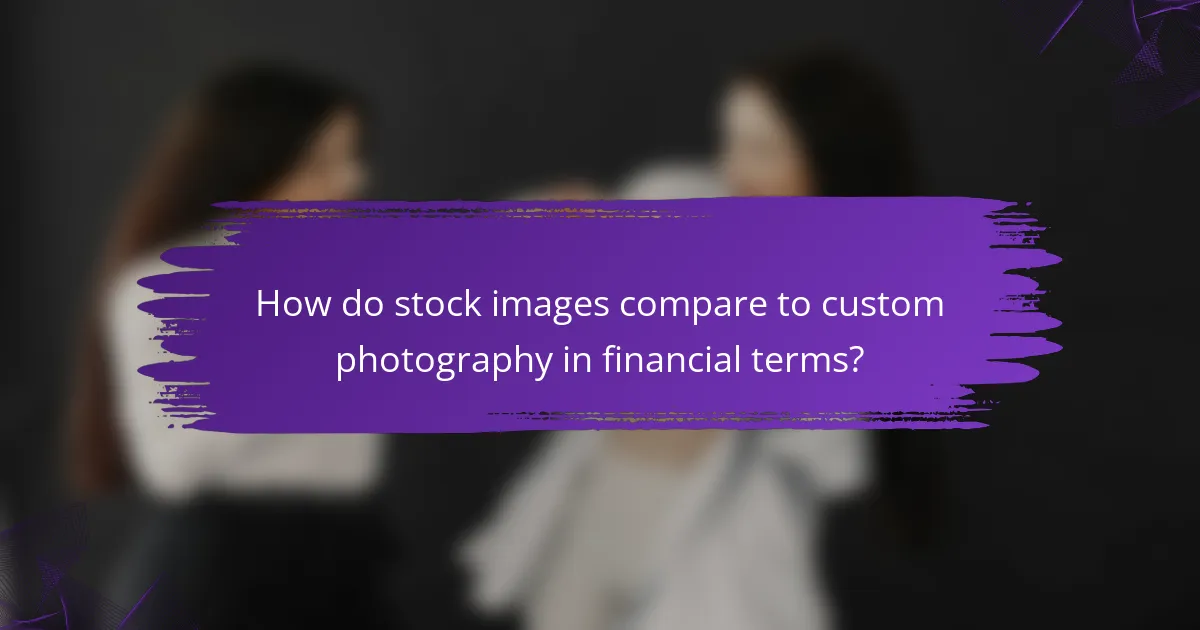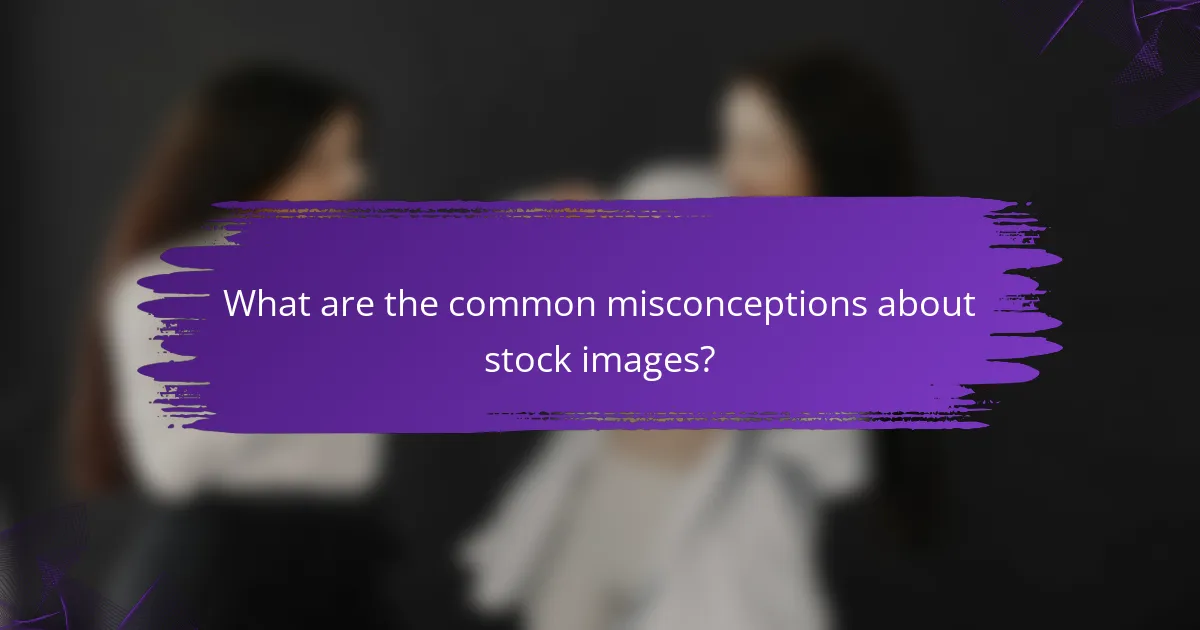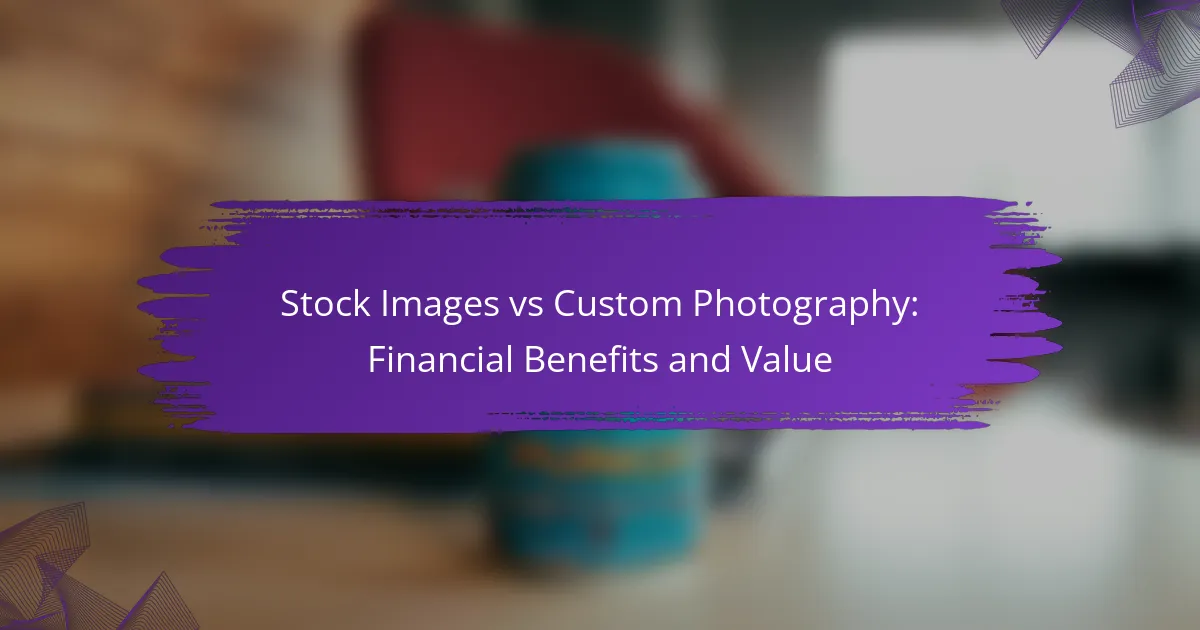When choosing between stock images and custom photography, businesses must weigh the initial cost against long-term value. While stock images offer a budget-friendly solution with flexible pricing, custom photography can enhance brand identity and foster deeper connections with audiences, ultimately leading to greater returns on investment. Understanding these financial implications is crucial for making an informed decision that aligns with marketing goals.

How do stock images compare to custom photography in financial terms?
Stock images typically have lower upfront costs compared to custom photography, making them an attractive option for many businesses. However, custom photography can provide higher long-term value, especially when considering brand identity and unique visual content.
Lower upfront costs of stock images
Stock images are often available for a one-time fee or through subscription services, making them budget-friendly for immediate needs. Prices can range from a few dollars to several hundred, depending on the quality and licensing. This affordability allows businesses to quickly access a wide variety of visuals without the need for extensive planning or production.
However, while stock images are inexpensive initially, the costs can accumulate if a business frequently purchases new images or requires specific themes that are not readily available. It’s essential to weigh the immediate savings against potential long-term needs.
Higher long-term value of custom photography
Custom photography offers a unique advantage by providing tailored images that align closely with a brand’s identity. This personalization can enhance brand recognition and customer loyalty over time. Although the initial investment is higher, often ranging from hundreds to thousands of dollars, the return can be significant in terms of brand differentiation.
Furthermore, custom images can be reused across multiple campaigns, maximizing their value. Businesses should consider how unique visuals can contribute to a cohesive brand narrative, which can justify the higher upfront costs.
Cost-effectiveness for small businesses
For small businesses, stock images can be a practical solution when budgets are tight. They allow for quick access to professional visuals without the need for a large financial commitment. This can be particularly beneficial for startups or businesses testing new marketing strategies.
However, small businesses should also evaluate the potential benefits of investing in custom photography as they grow. Unique images can help establish a strong brand presence, which may lead to increased customer engagement and sales over time.
Return on investment for marketing campaigns
The return on investment (ROI) for marketing campaigns can vary significantly between stock images and custom photography. Stock images may provide short-term gains in visibility, but they often lack the emotional connection that custom images can foster. Campaigns featuring unique visuals tend to resonate more with audiences, potentially leading to higher conversion rates.
To maximize ROI, businesses should analyze their target audience and campaign goals. Investing in custom photography for key marketing initiatives can yield better long-term results, while stock images may suffice for less critical applications. Balancing both options strategically can optimize overall marketing effectiveness.

What are the financial benefits of using stock images?
Using stock images can significantly reduce costs for businesses by providing affordable visual content without the need for extensive production budgets. Stock images often come with flexible pricing options, making them accessible for various projects and budgets.
Subscription models for stock image services
Many stock image platforms offer subscription models that allow users to download a certain number of images per month for a flat fee. This can be more economical than purchasing images individually, especially for companies that require frequent visual content.
For example, a subscription might cost around $30 to $200 per month, depending on the number of downloads and image quality. Businesses should evaluate their needs to choose a plan that maximizes value while minimizing excess costs.
Access to a wide range of visuals
Stock image libraries typically feature vast collections of visuals across various categories, styles, and themes. This extensive selection enables businesses to find images that fit their specific branding and messaging without the delays associated with custom photography.
Having access to diverse imagery can enhance marketing campaigns and social media posts, allowing for quick adjustments to visual strategies based on current trends or seasonal themes.
Reduced production costs
Utilizing stock images eliminates many expenses associated with custom photography, such as hiring photographers, models, and production teams. This can lead to savings in the low hundreds to thousands of dollars per project, depending on the scope of the shoot.
Additionally, stock images can be used immediately, which reduces the time to market for campaigns. Businesses should weigh the immediate financial benefits against the potential need for unique visuals that may require custom solutions in the long run.

What are the financial benefits of custom photography?
Custom photography can provide significant financial benefits by enhancing brand identity and driving customer engagement. Investing in tailored images often leads to better returns compared to stock photos, as they resonate more with target audiences and can be leveraged across various marketing channels.
Unique branding opportunities
Custom photography allows businesses to create a distinct visual identity that aligns with their brand values. This uniqueness can set a company apart in a crowded market, making it more memorable to consumers. For instance, a local café might showcase its atmosphere and signature dishes through original photos, reinforcing its brand story.
When developing custom images, consider how they reflect your brand’s personality. Consistency in style, color, and subject matter can enhance recognition and loyalty, ultimately leading to increased customer retention and sales.
Higher engagement rates
Using custom photography can significantly boost engagement rates on social media and websites. Audiences are more likely to interact with authentic, relatable images that reflect real experiences rather than generic stock photos. For example, posts featuring unique images often see higher likes, shares, and comments.
To maximize engagement, ensure that your custom images are relevant to your audience’s interests and emotions. Conducting A/B tests with different visuals can help identify which types resonate best, allowing for more effective marketing strategies.
Long-term asset creation
Custom photography serves as a long-term asset that can be reused across various campaigns and platforms. Unlike stock images, which may become overused or lose relevance, original photos can maintain their value and impact over time. Businesses can build a library of images that reflect their evolving brand narrative.
When planning a custom photography shoot, consider creating a diverse range of images that can be utilized for different purposes, such as social media, website content, and promotional materials. This approach not only saves costs in the long run but also ensures a cohesive brand presence across all channels.

How do usage rights affect costs in stock images vs custom photography?
Usage rights significantly influence the costs associated with stock images and custom photography. Stock images typically come with predefined licensing agreements, while custom photography grants broader ownership rights, impacting long-term value and expenses.
Licensing fees for stock images
Licensing fees for stock images can vary widely based on the image’s intended use, distribution, and exclusivity. Generally, prices may range from a few dollars for basic usage to several hundred dollars for high-resolution images with extended rights. It’s essential to read the licensing terms carefully to avoid unexpected costs or restrictions.
Common licensing types include royalty-free and rights-managed. Royalty-free images allow for multiple uses after a one-time fee, while rights-managed images often require additional payments for each use or specific conditions. Understanding these differences can help in budgeting for stock images.
Ownership rights in custom photography
Custom photography usually provides full ownership rights, meaning the client can use the images without ongoing fees or restrictions. This can be particularly beneficial for businesses looking to create a unique brand identity, as they can tailor the visuals to their specific needs. However, the upfront costs for custom photography are typically higher than stock images.
When commissioning custom photography, it’s crucial to establish clear agreements regarding usage rights, including how long the images can be used and for what purposes. This clarity can prevent potential disputes and ensure that the investment in custom photography delivers long-term value.

What are the criteria for choosing between stock images and custom photography?
Choosing between stock images and custom photography depends on factors like budget, brand identity, and time constraints. Each option has its advantages and limitations that can significantly impact your project’s success.
Project budget considerations
Budget is a critical factor when selecting between stock images and custom photography. Stock images typically have lower upfront costs, often ranging from a few dollars to a couple of hundred dollars, depending on licensing. In contrast, custom photography can require a larger investment, potentially ranging from hundreds to thousands of dollars, factoring in photographer fees, equipment, and post-production costs.
When budgeting, consider not only the immediate expenses but also the long-term value. Custom photography may yield unique images that enhance brand recognition, potentially offering better returns on investment over time.
Brand identity alignment
Brand identity alignment is essential when deciding between stock images and custom photography. Stock images may lack the specificity needed to convey your brand’s unique message and values, as they are often generic and widely used. Custom photography, however, allows for tailored visuals that reflect your brand’s personality, style, and target audience.
To ensure alignment, evaluate how well each option represents your brand’s story. If your brand emphasizes authenticity and originality, investing in custom photography is likely the better choice.
Time constraints for content creation
Time constraints can heavily influence your decision between stock images and custom photography. Stock images are readily available and can be downloaded instantly, making them ideal for projects with tight deadlines. This quick access allows for immediate use in marketing campaigns or social media posts.
On the other hand, custom photography requires planning, scheduling, and production time, which can delay project timelines. If time is of the essence, stock images may be the more practical option, while custom photography should be considered for projects with more flexible schedules.

What are the common misconceptions about stock images?
Many people believe that stock images lack originality and quality, but this is not always the case. While some stock photos may be generic, there are numerous high-quality options available that can effectively meet diverse needs.
Quality concerns
One major misconception is that stock images are of inferior quality compared to custom photography. In reality, many stock image providers offer high-resolution photos that are suitable for professional use, including marketing materials and websites.
When selecting stock images, consider the licensing agreements and the intended use. Some stock images come with restrictions that may limit their application, while others offer broader usage rights. Always check the terms to ensure they align with your project requirements.
To avoid quality issues, look for stock images from reputable sources that curate their collections. Websites that feature user-generated content may have a wider variety, but they can also include lower-quality images. Prioritize platforms known for their high standards, such as Shutterstock or Adobe Stock.
